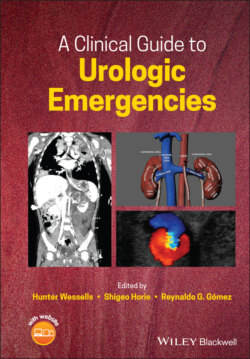Читать книгу A Clinical Guide to Urologic Emergencies - Группа авторов - Страница 42
Management Non‐Operative
ОглавлениеTraditionally, penetrating trauma has been managed with surgical exploration. However, there has been a shift toward more conservative management of trauma patients due to the improvements in imaging, interventional radiology, and resuscitation techniques. For hemodynamically stable patients, NOM with close patient observation should be offered as first‐line therapy [25].
Although there is no consensus algorithm for NOM and there is significant institutional variance, NOM generally comprise of bedrest, strict hemodynamic monitoring in a critical care unit, and serial hematocrit (HCT) checks. If patients are hemodynamically stable with down‐trending HCTs, they should be resuscitated with blood products. The presence of active bleeding on imaging, combined with transfusion requirement or hemodynamic instability, indicate that interventional radiology should be consulted for selective embolization. For patients with urinary extravasation, ureteral stenting should be considered, although optimal timing for stenting (early vs. late) is not currently known. We propose one management strategy in Figure 2.2. NOM, however, should not be equated to non‐interventional management. Rather, NOM should be viewed as an algorithmic approach with stepwise escalation of intervention based on patient dynamics (see Figure 2.3).
For renal injuries, the site of the wound, hemodynamic stability, and diagnostic imaging (grade of injury) are the main determinants for intervention. Although higher‐grade injuries (Grade IV and V) are more likely to require surgical exploration, with careful selection and staging, patients with PRI may be offered a trial of expectant management.
In one series, 54% of stab wounds were successfully managed non‐operatively, with only 3% of patients requiring exploration for delayed bleeding [31]. Another series found that stab wounds were more likely to be successfully managed with NOM if the site of abdominal wound penetration is posterior to the anterior axillary line [32].
PRI from low‐velocity GSWs can be managed with NOM. In one large series, approximately 30% of gunshot PRIs were successfully managed with observation [33]. As there is also a shift toward selective NOM for gunshot abdominal trauma wounds, there may be a larger impetus for NOM in patients with PRI who would not otherwise undergo surgical exploration [34].
Figure 2.2 Proposed Proposed treatment algorithm. CT, computed tomography; HCT, hematocrit; IR, interventional radiology; NOM, non‐operative management; NPO nothing by mouth; PRI, penetrating renal injury.
One quandary has been the management of suspected renal trauma in patients without pre‐operative CT imaging. Data suggests that even if patients are undergoing surgical exploration for associated non‐urologic injuries, renal exploration is not always necessary. The only absolute indication for renal exploration is a pulsatile or expanding retroperitoneal hematoma. Stable retroperitoneal hematomas should not be explored [24]. Obvious urinary leakage from a penetrating mechanism requires evaluation to exclude a renal pelvis or ureteral injury (see Figure 2.4). In one large series of patients undergoing exploratory laparotomy for renal GSWs, 56% of patients did not need renal exploration and renal exploration was associated with a 50% nephrectomy rate [35]. If patients undergo emergent laparotomy without imaging and a stable zone II (retroperitoneal flank) hematoma is not explored, they should receive appropriate renal imaging once stable, in order to evaluate the extent of the injury.
Figure 2.3 Twenty‐one‐year‐old male who sustained a GSW to the abdomen. He had a grade IV right PRI, with injuries to the liver and duodenum. (a) CT demonstrates a significant urine leak on initial delayed phase imaging. (b) He was taken to the operating room for retrograde pyelogram and ureteral stenting. Pyelogram demonstrates contrast extravasation from the middle calyx. Arrow depicts area of contrast extravasation. (c) Repeat CT scan with delayed phase imaging at two weeks demonstrates improved, but persistent contrast extravasation. He was taken to the operating room six weeks after ureteral stenting where retrograde pyelogram demonstrated complete healing of his collecting system and his stent was removed.
Source: courtesy of Jonathan Wingate, MD.
